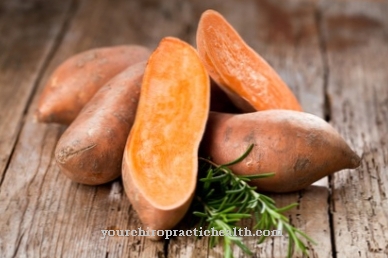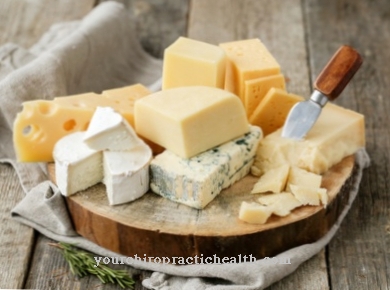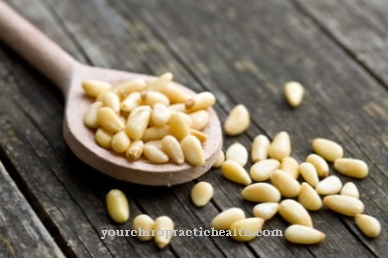Of the Wax gourd is an annual cucurbits originating in Southeast Asia. The fruits take on an ellipsoidal to spherical shape as they ripen and the skin is coated with a whitish, protective wax. The wax gourd is most important in Asian cuisine, where ripe and unripe fruits, leaves and flowers are used. In TCM, the wax gourd is also used as a remedy for stress-related disease symptoms.
What you should know about the wax gourd

The annual wax gourd (Benincasa hispida), of which well over a thousand species are known, is also called Winter melon referred to and belongs to the cucurbitaceae family. Like most types of pumpkin, the wax gourd is monoecious and forms separate male and female flowers on the same plant.
Most species are characterized by their soft hairs on almost all parts of the plant, except for the fruits. The shape and size of the fruits of the wax gourd are somewhat reminiscent of loaves of bread and weigh 10 to 15 kilograms, with some varieties up to 40 or even 100 kilograms. In some species, the fruits take on an almost spherical shape, and the dark green to blue-green skin is covered with a white layer of wax that protects the fruit from drying out and infection. Even after the harvest, the wax layer increases with longer storage. It can therefore be stored for months without noticeably losing freshness.
Due to the long shelf life and the possibility of harvesting twice in tropical regions, the wax gourd is available in stores all year round, so that there is practically no specific season or best time to buy the fruit. The taste and smell of the pulp are reminiscent of cucumber. Not only the pulp is suitable for consumption, but also young leaves and young flowers of the plant. In addition to the fruits, root extracts are also used for medicinal purposes.
The origin of the fast-growing plant is in Southeast Asia, where it has been of importance as a medicinal plant in TCM and Indian Ayurveda for probably more than two thousand years. It came to America via Cuba and is now grown in almost all tropical and subtropical regions.For example, the wax gourd is also grown in greenhouses in Holland and is usually sold from August to September. Wax pumpkins are most versatile used in Asian cuisine in the form of soups and as vegetable side dishes, not only when they are ripe, but also when they are still unripe.
Importance to health
The pulp of the wax gourd is not only reminiscent of the taste of cucumber, but the ingredients are also comparable to it. The importance of the wax gourd does not lie in its content of primary ingredients, because proteins, fats and carbohydrates are only available to a small extent.
The wax gourd can hardly come up with fiber either, so that it is at least easy to digest. Rather, the importance of the wax gourd lies in its content of secondary ingredients, some of which are relevant to health. The high content of potassium and some B vitamins is particularly noticeable. In TCM and Ayurvedic medicine, the pulp and root extracts are said to have diuretic, blood sugar-lowering and anti-inflammatory effects. The wax gourd is also important in the treatment of high blood pressure and stomach ulcers, as well as for the prevention of coronary artery diseases and for lowering fever.
The numerous flat seeds in the pulp contain valuable, polyunsaturated fatty acids, which are said to have a positive effect on the skin. The wax gourd is also used as a remedy for worm infestation in TCM.
Ingredients & nutritional values
| Nutritional information | Amount per 100 gram |
| Calories 13 | Fat content 0.2 g |
| cholesterol 0 mg | sodium 111 mg |
| potassium 6 mg | carbohydrates 3 g |
| Fiber 2.9 g | protein 0.4 g |
Due to its low content of primary ingredients, the nutritional value of the wax gourds is very low with 28 kilocalories per 100 grams of pulp. The carbohydrate content is only 5.7 grams. Proteins are in the amount of 0.9 grams and fats, except in the kernels, are practically non-existent. The fiber content is also negligible at 1 gram per 100 grams of pulp.
If only its primary ingredients are considered, the wax gourd could almost be considered a dietary food. The pumpkin scores with a few secondary ingredients. The potassium content is particularly important at 210 milligrams. The amounts of calcium (5.0 mg), magnesium (8.0 mg), sodium (12 mg) as well as sulfur (12 mg) and phosphorus (7.0 mg) are also worth mentioning. Vitamins A, B1, B2, B6 and vitamin E have a health-relevant vitamin content. The vitamin C content of 16 milligrams - measured against other vegetables - is to be assessed as below average.
Intolerances & allergies
Direct food intolerances and allergies related to wax gourd are rare. If intolerance is found, the symptoms usually show a mild course.
However, if intolerance or allergies to another type of pumpkin are known, the likelihood is high that the symptoms will occur in a similar or less pronounced form after consuming waxed pumpkin. In rare cases, symptoms such as reddening of the face, swelling of the face or lips, or rashes occur. In extremely rare cases, anaphylactic shock can occur.
Shopping & kitchen tips
Wax gourds are not to be found in every supermarket or fruit shop, because the vegetable has not (yet) found widespread distribution in Germany. When buying, you should make sure that the wax layer of the shell is as intact as possible and that it feels quite hard and has no dents.
In principle, wax gourds are available all year round. The most important export country for Germany is Thailand. Wax pumpkins can be stored for months without any problems if they are intact. Only the shelf life of very young wax pumpkins is limited. It is only about 2 weeks in the refrigerator. Very young wax gourds can be made into soups completely with their peel. The soup should simmer for at least an hour as this will allow the pulp to absorb flavor aromas. Wax squash can also be cooked.
To do this, the cap is cut off at one end, about two thirds of the pulp is removed and the wax gourd is filled with a filling to cook it afterwards. The fruits are less suitable for braising due to their high water content.
Preparation tips
A classic way of preparing a wax pumpkin is to peel the pumpkin, remove the seeds from the pulp, then dice it and cook it like other vegetables and use it as an accompaniment to dishes.
While the Chinese prefer to use the wax gourd into soups, the pulp is also used in Indonesia to make a sweet snack. The diced pulp is soaked in a sweet marinade and then dried. The small, dried pieces are then served as a snack with drinks such as tea or coffee or processed into pastries and cakes.
























.jpg)



